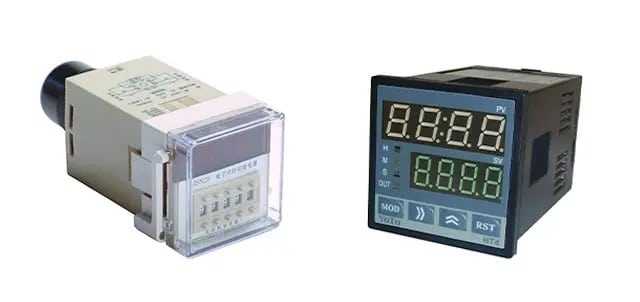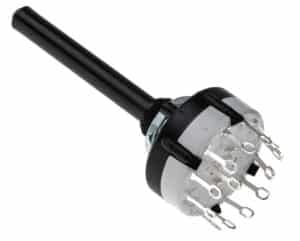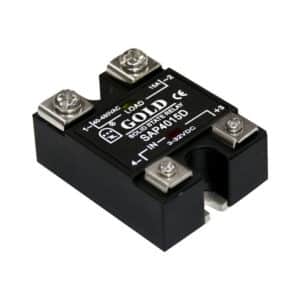What is a Relay?
A relay is an electromechanical switch, an essential component in electronic circuits, designed to control a high power or high voltage circuit with a low power signal. The fundamental principle of a relay is simple: it uses a small electromagnetic signal to control a larger circuit. This is achieved through a coil and a series of contacts within the relay. When an electric current passes through the coil, it generates a magnetic field, which either opens or closes the contacts, thus controlling the circuit.
The beauty of a relay lies in its ability to control one or more circuits by a separate low-power signal. This not only provides a level of safety, isolating the control circuit from the high-power circuit, but also offers the flexibility of switching between different circuits without direct human intervention.
There are more than a few types of relays, each designed to fulfill specific requirements in electronic circuits. From the electromagnetic relay, which uses a coil magnetically operated switch, to the solid-state relay, which operates without moving parts, each type has its unique working principle and applications. Thermal relays, sensitive to temperature changes, offer protection in overheating scenarios, while reed relays, known for their fast operation and small size, are ideal for compact and high-speed switching applications.
Understanding the basic function and types of relays is crucial for anyone involved in the design and maintenance of electronic systems. As we progress, we will delve deeper into each type of relay, exploring their working principles, advantages, disadvantages, and where they are best used in the world of electronics.
Types of Relays 1: Electromagnetic Relays
Working Principles of Electromagnetic Relays
Electromagnetic relays operate based on the principles of electromagnetism. When an electric current passes through a coil within the relay, it creates a magnetic field. This magnetic field activates an armature, which then either makes or breaks a connection in the circuit. The armature’s movement is what switches the circuit on or off, or switches between different circuits. This basic mechanism allows electromagnetic relays to control complex circuits with a relatively simple electromagnetic trigger.

Advantages and Disadvantages of Electromagnetic Relays
Advantages:
- Simplicity and Reliability: Their simple design makes electromagnetic relays highly reliable.
- Cost-Effectiveness: Generally, they are more affordable than other types of relays.
- Isolation: These relays provide excellent electrical isolation between control and load circuits.
- Versatility: Suitable for a wide range of applications, including industrial and domestic settings.
Disadvantages:
- Physical Wear: Being mechanical in nature, they are subject to wear and tear over time.
- Slower Operation: They tend to operate slower than solid-state relays.
- Noise: The physical movement of the armature can produce a noticeable clicking sound.
- Limited Switching Speed: They are not ideal for applications requiring very fast switching.
Characteristics of Electromagnetic Relays
- Switching Capacity: They can handle a wide range of voltages and currents.
- Design: Typically consist of a coil, an armature, a spring, and one or more sets of contacts.
- Response Time: They have a moderate response time compared to other relay types.
- Size: Generally larger than solid-state relays due to their mechanical components.
Use Cases of Electromagnetic Relays
Electromagnetic relays are widely used in various applications, including:
- Automotive Systems: For controlling headlights, wipers, and other car functionalities.
- Industrial Automation: In controlling motors, lights, and other heavy machinery.
- Home Appliances: Used in washing machines, refrigerators, and air conditioners for controlling various functions.
- Power Systems: In circuit breakers and other safety mechanisms to protect against overloads.
Electromagnetic relays, with their unique combination of simplicity, reliability, and versatility, continue to be a staple in both simple and complex electronic circuits. Their ability to control large power loads with small signals makes them invaluable in a wide range of applications.
Types of Relays 2: Solid State Relays
Working Principles of Solid State Relays
Solid State Relays (SSRs) function differently from electromagnetic relays. They use semiconductor devices like thyristors, triacs, or transistors to switch the circuit. When a control voltage is applied, the semiconductor switches to a conductive state, allowing current to pass through. Unlike electromagnetic relays, SSRs have no moving parts. This electronic switching method results in a faster and quieter operation compared to the mechanical movement found in electromagnetic relays.

Advantages and Disadvantages of Solid State Relays
Advantages:
- Speed: They offer much faster switching times than electromagnetic relays.
- Durability: Lack of moving parts reduces wear and tear, increasing longevity.
- Silent Operation: SSRs operate silently, as there are no physical contacts moving.
- No Contact Sparking: Since there are no physical contacts, there is no risk of sparking, making SSRs safer in certain environments.
Disadvantages:
- Heat Generation: SSRs can generate significant heat during operation and often require heat sinks.
- Limited Load Types: They are usually less flexible with the types of loads they can control, especially inductive loads.
- Cost: Generally, SSRs are more expensive than electromagnetic relays.
- Voltage Drop: A small voltage drop occurs across the relay, which can be significant in some low-voltage applications.
Characteristics of Solid State Relays
- Switching Type: Electronic switching using semiconductors.
- Input-Output Isolation: Usually achieved through optical coupling.
- Load Range: Best suited for moderate to high-power applications.
- Form Factor: Compact design due to the absence of mechanical parts.
Use Cases of Solid State Relays
Solid State Relays are extensively used in areas where high-speed switching, reliability, and durability are crucial:
- Industrial Process Controls: For precise control in manufacturing processes.
- Temperature Controllers: In applications requiring precise temperature regulation like in ovens and incubators.
- Lighting Control Systems: For fast and efficient control of lighting circuits.
- Computer Interface Applications: Where fast and silent operation is necessary for interfacing with computer-controlled systems.
These types of relays offer a technologically advanced solution for switching needs in modern electronic applications. Their fast, quiet, and reliable performance makes them a preferred choice in many high-demand electronic environments.
Types of Relays 3: Thermal Relays
Working Principles of Thermal Relays
Thermal relays operate based on thermal effects caused by electric current. These relays contain a bimetallic strip or a thermally sensitive element that responds to the heat generated by the current flow. When the current exceeds a predetermined level, the heat causes the bimetallic strip to bend or the element to react, triggering the relay to open or close the circuit. This action is designed to provide protection against overload conditions, making thermal relays an essential component in safeguarding electrical systems.

Advantages and Disadvantages of Thermal Relays
Advantages:
- Overload Protection: Specifically designed to protect motors and circuits from overheating and overload.
- Simplicity and Cost-Effectiveness: They are relatively simple in design and lower in cost compared to more complex relay types.
- Self-Resetting: Many thermal relays automatically reset when the temperature returns to normal.
Disadvantages:
- Slow Response: They respond slower than electromagnetic or solid-state relays, as they rely on thermal changes.
- Limited Sensitivity: Not as precise as other types of relays for detecting overloads or faults.
- Ambient Temperature Influence: Their operation can be affected by the ambient temperature, leading to potential inaccuracies.
Characteristics of Thermal Relays
- Sensitivity to Current: Designed to react to specific current levels that cause excessive heat.
- Reset Mechanism: Typically have manual or automatic resetting options.
- Construction: Often incorporate a bimetallic strip and a calibration mechanism for setting the trigger point.
- Temperature Range: Effective within a specific temperature range, beyond which their reliability may decrease.
Use Cases of Thermal Relays
Thermal relays find their primary application in protecting electric motors and other devices from overheating due to overload:
- Motor Protection: In industrial motors to prevent damage due to sustained overload conditions.
- Heating Systems: Used in heating appliances to prevent overheating.
- Circuit Protection: In electrical circuits as a safeguard against prolonged overcurrent situations.
- Home Appliances: Integrated into various household appliances for safety against electrical overloads.
These types of relays play a crucial role in ensuring the longevity and safe operation of electrical systems. Their ability to respond to overcurrent conditions through a simple yet effective mechanism makes them an indispensable component in various electrical and electronic applications.
Types of Relays 4: Reed Relays
Working Principles of Reed Relays
Reed relays consist of a pair of magnetic, metal reeds encased within a glass tube. These reeds act as the switch contacts. The relay operates when a magnetic field, generated by an electric current passing through a coil surrounding the tube, pulls the reeds together, thus closing the circuit. When the magnetic field is removed, the reeds separate due to their inherent elasticity, opening the circuit. This design allows for very fast switching speeds and a compact form factor, making reed relays unique in their operation and applications.

Advantages and Disadvantages of Reed Relays
Advantages:
- Fast Switching Speed: Reed relays can switch much faster than electromagnetic relays.
- Compact Size: Their small size makes them ideal for space-constrained applications.
- Low Power Consumption: They require very little power to operate, which is beneficial in low-power circuits.
- Hermetically Sealed Contacts: This feature ensures a high level of reliability and a longer lifespan, as it protects the contacts from external contaminants.
Disadvantages:
- Limited Contact Rating: Reed relays generally have lower current and voltage ratings compared to other types of relays.
- Sensitivity to Magnetic Fields: External magnetic fields can inadvertently operate the relay, necessitating careful design and shielding.
- Mechanical Fragility: The glass enclosure of the reeds can be fragile, requiring careful handling.
Characteristics of Reed Relays
- Switching Mechanism: Utilizes magnetic reeds within a glass tube.
- Size and Shape: Typically small and cylindrical, fitting easily into compact electronic assemblies.
- Response Time: Offers very rapid response times, suitable for high-speed applications.
- Operating Voltage and Current: Generally designed for low to moderate voltage and current applications.
Use Cases of Reed Relays
Reed relays are commonly used in applications where high-speed switching and reliability in a small package are crucial:
- Telecommunications Equipment: For fast and reliable switching in communication systems.
- Test and Measurement Equipment: In devices requiring accurate and rapid switching.
- Medical Equipment: For precise and reliable operation in sensitive medical electronics.
- Security Systems: Utilized in security and alarm systems for their fast response times and compact size.
Reed relays, with their unique combination of speed, compactness, and energy efficiency, play a vital role in modern electronics, especially where space and power consumption are of paramount concern.
Table of Comparison for 4 Types of Relays
In this section, we provide a comparative analysis of the different types of relays we’ve discussed: Electromagnetic, Solid State, Thermal, and Reed Relays. This comparison will help highlight their distinct features, making it easier to understand their specific applications and advantages.
| Feature | Electromagnetic Relays | Solid State Relays | Thermal Relays | Reed Relays |
| Switching Mechanism | Electromechanical | Electronic | Thermal | Magnetic |
| Switching Speed | Moderate | Fast | Slow | Very Fast |
| Noise Level | Audible clicking | Silent | Silent | Silent |
| Durability | Moderate (mechanical wear) | High (no moving parts) | Moderate | High (but glass is fragile) |
| Application | General purpose, Automotive | Precise control, Industrial | Overload protection, Motors | High-speed, Telecommunication |
| Cost | Lower | Higher | Lower | Moderate |
| Size | Larger | Compact | Moderate | Very Compact |
| Voltage/Current Range | Wide range | Moderate to high | Low to moderate | Low to moderate |
Key Takeaways:
- Electromagnetic Relays: These types of relays are ideal for general-purpose applications where cost and versatility are key.
- Solid State Relays: These types of relays are best suited for situations requiring fast, silent, and reliable switching.
- Thermal Relays: These types of relays are essential for protecting systems from overheating, particularly in motors and heating appliances.
- Reed Relays: These types of relays are optimal for high-speed applications and where space is at a premium, such as in telecommunications and compact electronic devices.
This table serves as a quick reference guide to understand the fundamental differences between these relay types and their suitability for various applications in the field of electronics.
Powering the Future: The Integral Role of Relays in Advancing Electronics
As we have explored the various types of relays – electromagnetic, solid state, thermal, and reed – it becomes evident that these components are more than just switches. They are fundamental in shaping the efficiency, safety, and functionality of modern electronic systems. Each type of relay, with its unique characteristics and capabilities, caters to specific needs within the vast realm of electronics, from everyday appliances to sophisticated industrial machinery.
The versatility of relays underscores their irreplaceable role in current and future technological advancements. Whether it’s in ensuring the safety of electrical systems with thermal relays, the precise control in industrial processes with solid-state relays, the reliable operation in automotive and household appliances with electromagnetic relays, or the high-speed performance in telecommunication systems with reed relays, all types of relays are integral to the ongoing evolution of electronic technology.
FAQs
- What is the main function of a relay in an electronic circuit?
The main function of a relay is to control a high power or high voltage circuit with a low power signal. It acts as an electromechanical switch, allowing for the control of large power loads with minimal input. - How do solid-state relays differ from electromagnetic relays?
Solid-state relays use semiconductor devices to switch the circuit and have no moving parts, resulting in faster, quieter, and more reliable operation. In contrast, electromagnetic relays use a coil and mechanical switch, which can be slower and subject to wear and tear. - Which of the 4 types of relays are used to protect electrical systems?
Thermal relays are crucial for protecting electrical systems from overheating and overloading. They respond to excessive current by opening the circuit, preventing damage to the system and connected devices. - In what applications are reed relays most commonly used?
Reed relays are widely used in telecommunications, test and measurement equipment, medical devices, and security systems, where their fast switching speeds, compact size, and reliability are highly valued. - Can relays be used for both AC and DC applications?
Yes, different types of relays can be designed for different AC and DC applications. The choice of relay type depends on the specific requirements of the circuit, including voltage, current, and switching speed.


